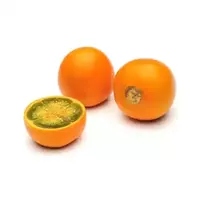Naranhilla

Surely many connoisseurs of exotic fruits have long been familiar with the so-called fruit and vegetable culture, which belongs to the nightshade family - pepino or melon pear. This fruit miraculously combines the advantages of fruit and berry and vegetable crops. However, there are other representatives in this family that produce the same healthy and unusually tasty fruits. By the way, almost all of them are somehow related to the ancient Inca civilization.
The continent of South America, in particular its Andean region, is one of the largest centers of origin of numerous crops of special interest to agriculture. As you know, it was from the Incas that the inhabitants of Europe borrowed corn, tomato, potatoes and many other plants. So, we can safely add to their number naranhill, which is often called the "golden fruit of the Andes. "
In appearance, orange-yellow colored naranjilla fruits are very similar to miniature oranges. By the way, this is why they got their name: translated from Spanish, Naranha means orange. In addition, the second name of this exotic fruit, lulo, is quite common.
The naranhill plant is a perennial herbaceous bush, which is characterized by a thick stem and huge dark green leaves with bright veins of lilac color. The leaves of this plant are unusually attractive, therefore they are of particular interest to gardeners.
Flowers and mature naranjilla fruits are covered with soft felt over the entire surface. The diameter of the fruit is on average from 3 to 8 centimeters with a weight of 50-70 grams. In the cut, Naranhill resembles tomato and physalis. Yellow-green pulp, in which a fairly large amount of small seeds is present, is characterized by an acidic taste.
In Costa Rica, Panama, Venezuela and Guatemala, juicy fruits are mainly used to make juice with pulp, which is consumed both in pure form or when mixed with other drinks, and for the further preparation of aromatic fruit gravies, ice cream, fruit salads, yoghurts, biscuits and wine. In Colombia and Ecuador, a drink of naranjilla fruits can often be found on the menus of hotels and restaurants. By the way, most Latin Americans prefer a naranjilla drink to such a popular orange juice.
The delicate felt that covers the fruits is easily washed away under running water. The fruits cleaned from the thin skin are wiped through a sieve, after which the resulting mass is diluted with a small amount of boiled water. The finished juice from naranjilla is green, as well as the delicate taste and aroma of strawberries, pineapple and tomato.
Naranhillas 25 kCal
Energy value of naranjilla (Ratio of proteins, fats, carbohydrates - ju):
Proteins: 0.44 g (~ 2 kCal)
Fats: 0.22 g (~ 2 kCal)
Carbohydrates: 5.6 g (~ 22 kCal)
Energy ratio (b | y): 7% | 8% | 90%
 Español
Español Français
Français Português
Português Русский
Русский 简体中文
简体中文 繁體中文
繁體中文 日本語
日本語 한국어
한국어 العربية
العربية Türkçe
Türkçe Қазақ
Қазақ Deutsch
Deutsch Italiano
Italiano Українська
Українська
